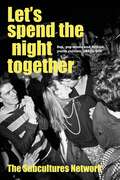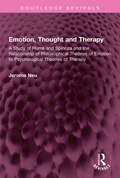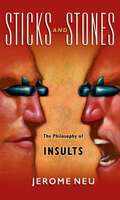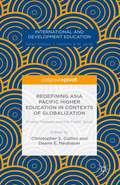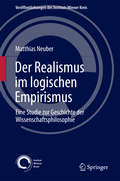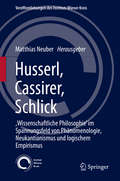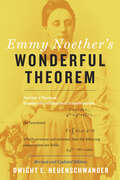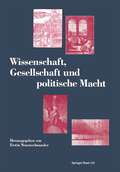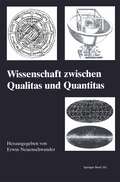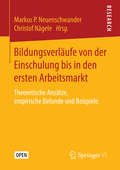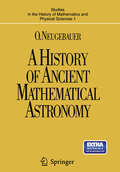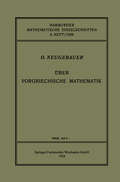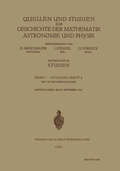- Table View
- List View
Al-Farabi and His School
by Ian Richard NettonExamines one of the most exciting and dynamic periods in the development of medieval Islam, from the late 9th to the early 11th century, through the thought of five of its principal thinkers, prime among them al-Farabi. This great Islamic philosopher, called 'the Second Master' after Aristotle, produced a recognizable school of thought in which others pursued and developed some of his own intellectual preoccupations. Their thought is treated with particular reference to the most basic questions which can be asked in the theory of knowledge or epistemology. The book thus fills a lacuna in the literature by using this approach to highlight the intellectual continuity which was maintained in an age of flux. Particular attention is paid to the ethical dimensions of knowledge.
Al-Farabi and His School
by Ian Richard NettonExamines one of the most exciting and dynamic periods in the development of medieval Islam, from the late 9th to the early 11th century, through the thought of five of its principal thinkers, prime among them al-Farabi. This great Islamic philosopher, called 'the Second Master' after Aristotle, produced a recognizable school of thought in which others pursued and developed some of his own intellectual preoccupations. Their thought is treated with particular reference to the most basic questions which can be asked in the theory of knowledge or epistemology. The book thus fills a lacuna in the literature by using this approach to highlight the intellectual continuity which was maintained in an age of flux. Particular attention is paid to the ethical dimensions of knowledge.
Muslim Neoplatonists: An Introduction to the Thought of the Brethren of Purity
by Ian Richard NettonThe tenth or eleventh century group of the Brethren of Purity (Ikhwan al Safa) are as well known in the Arab world as Darwin, Marx and Freud in the west. Designed as an introduction to their ideas, this book concentrates on the Brethren's writings, analyzing the impact on them of thinkers such as Pythagoras, Plato, Aristotle and the Neoplatonists. Ian Netton traces the influences of Judaism and Christianity, and controversially this book argues that the Brethren of Purity did not belong to the Ismaili branch of Islam as is generally believed.
Muslim Neoplatonists: An Introduction to the Thought of the Brethren of Purity
by Ian Richard NettonThe tenth or eleventh century group of the Brethren of Purity (Ikhwan al Safa) are as well known in the Arab world as Darwin, Marx and Freud in the west. Designed as an introduction to their ideas, this book concentrates on the Brethren's writings, analyzing the impact on them of thinkers such as Pythagoras, Plato, Aristotle and the Neoplatonists. Ian Netton traces the influences of Judaism and Christianity, and controversially this book argues that the Brethren of Purity did not belong to the Ismaili branch of Islam as is generally believed.
Let’s spend the night together: Sex, pop music and British youth culture, 1950s–80s
by Subcultures NetworkLet’s spend the night together explores how sex and sexuality provided essential elements of British youth culture in the 1950s through to the 1980s. It shows how the underlying sexual charge of rock ‘n’roll – and pop music more generally – was integral to the broader challenge embodied in the youth cultures that developed after World War Two. As teenage hormones rushed to move to the music and take advantage of the spaces opening up through consumption, education and employment, so the boundaries of British morality and cultural propriety were tested and often transgressed. Be it the assertive masculinity of the teds or the lustful longings of the teeny-bopper, the gender-bending of glam or the subterranean allure of an underground club/disco, the free love of the 1960s or the punk provocations in the 1970s, sex was forever to the fore and, more often than not, underpinned the moral panics that fitfully followed any cultural shift in youthful style and behaviour. Drawing from scholarship across a range of disciplines, the Subcultures Network explore how sex and sexuality were experienced, presented, conferred, responded to and understood within the context of youth culture, popular music and social change in the period between World War Two and the advent of AIDS. The essays locate sex, music and youth culture in the context of post-war Britain: with a widening and ever-more prevalent media; amidst the loosening bonds of censorship; in a society shaped by changing patterns of consumption and the emergence of the ‘teenager’; existing, as Jeff Nuttall famously argued, under the shadow of the (nuclear) bomb.
Emotion, Thought and Therapy: A Study of Hume and Spinoza and the Relationship of Philosophical Theories of Emotion to Psychological Theories of Therapy (Routledge Revivals)
by Jerome NeuFirst published in 1977, Emotion, Thought and Therapy is a study of Hume and Spinoza and the relationship of philosophical theories of the emotions to psychological theories of therapy. Jerome Neu argues that the Spinozists are closer to the truth; that is, that thoughts are of greater importance than feelings in the classification and discrimination of emotional states. He then contends that if the Spinozists are closer to the truth, we have the beginning of an argument to show that Freudian or analytic therapies make philosophic sense. Throughout the book, careful attention is paid to modern discussions in philosophy of mind and psychology, and materials from anthropology and other relevant disciplines are considered. At the centre of the discussion is the notion of ‘thought-dependence’. Therapies for psychological disorders are placed along a spectrum in accordance with the role they assign to thoughts. The Spinozist view of the emotions can be seen as at the extreme thought end of a corresponding spectrum of theories of the emotions. The book suggests that this stream may help explain the spectrum of therapeutic theories and the possibilities that exist for psychological development and change. This book will be of interest to students of philosophy, psychology and counselling.
Emotion, Thought and Therapy: A Study of Hume and Spinoza and the Relationship of Philosophical Theories of Emotion to Psychological Theories of Therapy (Routledge Revivals)
by Jerome NeuFirst published in 1977, Emotion, Thought and Therapy is a study of Hume and Spinoza and the relationship of philosophical theories of the emotions to psychological theories of therapy. Jerome Neu argues that the Spinozists are closer to the truth; that is, that thoughts are of greater importance than feelings in the classification and discrimination of emotional states. He then contends that if the Spinozists are closer to the truth, we have the beginning of an argument to show that Freudian or analytic therapies make philosophic sense. Throughout the book, careful attention is paid to modern discussions in philosophy of mind and psychology, and materials from anthropology and other relevant disciplines are considered. At the centre of the discussion is the notion of ‘thought-dependence’. Therapies for psychological disorders are placed along a spectrum in accordance with the role they assign to thoughts. The Spinozist view of the emotions can be seen as at the extreme thought end of a corresponding spectrum of theories of the emotions. The book suggests that this stream may help explain the spectrum of therapeutic theories and the possibilities that exist for psychological development and change. This book will be of interest to students of philosophy, psychology and counselling.
On Loving Our Enemies: Essays in Moral Psychology
by Jerome NeuThis book explores moral questions that go beyond the issues commonly considered in the ethics of action.
Sticks and Stones: The Philosophy of Insults
by Jerome Neu"Sticks and stones may break my bones but words will never hurt me." This schoolyard rhyme projects an invulnerability to verbal insults that sounds good but rings false. Indeed, the need for such a verse belies its own claims. For most of us, feeling insulted is a distressing-and distressingly common-experience. In Sticks and Stones, philosopher Jerome Neu probes the nature, purpose, and effects of insults, exploring how and why they humiliate, embarrass, infuriate, and wound us so deeply. What kind of injury is an insult? Is it determined by the insulter or the insulted? What does it reveal about the character of both parties as well as the character of society and its conventions? What role does insult play in social and legal life? When is telling the truth an insult? Neu draws upon a wealth of examples and anecdotes-as well as a range of views from Aristotle and Oliver Wendell Holmes to Oscar Wilde, John Wayne, Katherine Hepburn, and many others-to provide surprising answers to these questions. He shows that what we find insulting can reveal much about our ideas of character, honor, gender, the nature of speech acts, and social and legal conventions. He considers how insults, both intentional and unintentional, make themselves felt-in play, Freudian slips, insult humor, rituals, blasphemy, libel, slander, and hate speech. And he investigates the insult's extraordinary power, why it can so quickly destabilize our sense of self and threaten our moral identity, the very center of our self-respect and self-esteem. Entertaining, humorous, and deeply insightful, Sticks and Stones unpacks the fascinating dynamics of a phenomenon more often painfully experienced than clearly understood.
A Tear Is an Intellectual Thing: The Meanings of Emotion
by Jerome NeuIs jealousy eliminable? If so, at what cost? What are the connections between pride the sin and the pride insisted on by identity politics? How can one question an individual's understanding of their own happiness or override a society's account of its own rituals? What makes a sexual desire "perverse," or particular sexual relations (such as incestuous ones) undesirable or even unthinkable? These and other questions about what sustains and threatens our identity are pursued using the resources of philosophy, psychoanalysis, and other disciplines. The discussion throughout is informed and motivated by the Spinozist hope that understanding our lives can help change them, can help make us more free.
Redefining Asia Pacific Higher Education in Contexts of Globalization: Private Markets And The Public Good (International and Development Education)
by Deane E. Neubauer Christopher S. CollinsThis edited volume addresses the dynamic global contexts redefining Asia Pacific higher education, including cross-border education, capacity and national birthrate profiles, pressures created within ranking/status systems, and complex shifts in the meanings of the public good that influence public education in an increasingly privatized world.
Der Realismus im logischen Empirismus: Eine Studie zur Geschichte der Wissenschaftsphilosophie (Veröffentlichungen des Instituts Wiener Kreis #27)
by Matthias NeuberIn der Studie geht Matthias Neuber der Frage nach, in welchem Verhältnis das Konzept des Realismus und der logische Empirismus des Wiener Kreises, eine der dominanten Strömungen der deutschsprachigen theoretischen Philosophie des frühen 20. Jahrhunderts, zueinander stehen. Diese Fragestellung ist in der philosophiehistorischen Forschung bislang nur am Rande behandelt worden. Das ist umso erstaunlicher, als die neuere wissenschaftsphilosophische Realismusdebatte gerade durch den logischen Empirismus maßgeblich mitbestimmt worden ist. Der Autor geht aber noch einen Schritt weiter: Er begründet in dem Band die These, dass es innerhalb des logischen Empirismus selbst Strömungen gab, die mit dem wissenschaftlichen Realismus kompatibel sind. Damit bezieht er eine Gegenposition zum Mainstream in der Deutung der wissenschaftsphilosophischen Realismusdebatte des 20. Jahrhunderts, denn der versteht den wissenschaftlichen Realismus als Gegenprogramm zum logischen Empirismus. Neuber liefert mit seiner philosophiehistorischen Studie nicht weniger als eine Neubewertung des Verhältnisses von Realismus und logischem Empirismus. Ein Werk, das sich insbesondere an Wissenschaftler, aber auch an fortgeschrittene Studierende auf dem Gebiet der Geschichte der Wissenschaftsphilosophie richtet.
Die Grenzen des Revisionismus: Schlick, Cassirer und das ‚Raumproblem‘ (Schlick Studien #2)
by Matthias Neuber"Die Grenzen des Revisionismus" befasst sich mit den erkenntnis- und wissenschafttheoretischen Positionen des frühen Moritz Schlick (1882-1936) und des frühen Ernst Cassirer (1874-1945). Was die Positionen dieser beiden Autoren in starkem Maße kennzeichnet, ist, dass im Kontext einer durch die theoretische Philosophie Immanuel Kants geprägten Diskursstruktur argumentiert wird. Dieses Vorhaben wird hier als ‚transzendentaler Revisionismus‘ bezeichnet. Das Ziel dieses Buches ist es verständlich zu machen, dass dem transzendental-revisionistischen Vorhaben klare Grenzen gesetzt sind.
Husserl, Cassirer, Schlick: ,Wissenschaftliche Philosophie’ im Spannungsfeld von Phänomenologie, Neukantianismus und logischem Empirismus (Veröffentlichungen des Instituts Wiener Kreis #23)
by Matthias NeuberPhänomenologie, Neukantianismus und logischer Empirismus waren die dominanten Strömungen in der deutschsprachigen theoretischen Philosophie des frühen 20. Jahrhunderts. Die Beziehungen dieser drei philosophischen Positionen untereinander wurden in der philosophiehistorischen Forschung bisher allenfalls in Teilkonstellationen untersucht. Der Band liefert erstmals eine Zusammenschau dieser drei Positionen. Die Autoren gehen in ihren Aufsätzen der Frage auf den Grund, wie die Beziehungen zueinander zu bestimmen sind und zwar unter dem Gesichtspunkt der wissenschaftlichen Philosophie, dem Projekt, das alle drei Protagonisten – Edmund Husserl, Ernst Cassirer und Moritz Schlick – verfolgten und dabei jeweils eine eigene Version entwickelten. Die Aufsätze sind in drei Blöcken zusammengefasst. Der erste Block widmet sich Edmund Husserls Phänomenologie, der zweite Ernst Cassirers Neukantianismus und der dritte dem logischem Empirismus von Moritz Schlick. In ihren Beiträgen stellen die Autoren immer wieder Bezüge zu den jeweils anderen Protagonisten und ihren für die Fragestellung maßgeblichen Schriften her. Der Band richtet sich an Forscher und Studierende, die sich mit der Geschichte der Wissenschaftsphilosophie befassen und die Struktur des Diskurses in der ‚kontinentalen‘ Philosophie des frühen 20. Jahrhunderts nachvollziehen möchten.
Ernest Nagel: Philosophy of Science and the Fight for Clarity (Logic, Epistemology, and the Unity of Science #53)
by Matthias Neuber Adam Tamas TubolyThis volume is dedicated to the life and work of Ernest Nagel (1901-1985) counted among the influential twentieth-century philosophers of science. Forgotten by the history of philosophy of science community in recent years, this volume introduces Nagel’s philosophy to a new generation of readers and highlights the merits and originality of his works.Best known in the history of philosophy as a major American representative of logical empiricism with some pragmatist and naturalist leanings, Nagel’s interests and activities went beyond these limits. His career was marked with a strong and determined intention of harmonizing the European scientific worldview of logical empiricism and American naturalism/pragmatism. His most famous and systematic treatise on, The Structure of Science, appeared just one year before Thomas Kuhn’s even more renowned, The Structure of Scientific Revolutions. As a reflection of Nagel’s interdisciplinary work, the contributing authors’ articles are connected both historically and systematically. The volume will appeal to students mainly at the graduate level and academic scholars. Since the volume treats historical, philosophical, physical, social and general scientific questions, it will be of interest to historians and philosophers of science, epistemologists, social scientists, and anyone interested in the history of analytic philosophy and twentieth-century intellectual history.
Emmy Noether's Wonderful Theorem
by Dwight E. Neuenschwander"In the judgment of the most competent living mathematicians, Fräulein Noether was the most significant creative mathematical genius thus far produced since the higher education of women began."â€�Albert EinsteinThe year was 1915, and the young mathematician Emmy Noether had just settled into Göttingen University when Albert Einstein visited to lecture on his nearly finished general theory of relativity. Two leading mathematicians of the day, David Hilbert and Felix Klein, dug into the new theory with gusto, but had difficulty reconciling it with what was known about the conservation of energy. Knowing of her expertise in invariance theory, they requested Noether’s help. To solve the problem, she developed a novel theorem, applicable across all of physics, which relates conservation laws to continuous symmetriesâ€�one of the most important pieces of mathematical reasoning ever developed.Noether’s "first" and "second" theorem was published in 1918. The first theorem relates symmetries under global spacetime transformations to the conservation of energy and momentum, and symmetry under global gauge transformations to charge conservation. In continuum mechanics and field theories, these conservation laws are expressed as equations of continuity. The second theorem, an extension of the first, allows transformations with local gauge invariance, and the equations of continuity acquire the covariant derivative characteristic of coupled matter-field systems. General relativity, it turns out, exhibits local gauge invariance. Noether’s theorem also laid the foundation for later generations to apply local gauge invariance to theories of elementary particle interactions. In Dwight E. Neuenschwander’s new edition of Emmy Noether’s Wonderful Theorem, readers will encounter an updated explanation of Noether’s "first" theorem. The discussion of local gauge invariance has been expanded into a detailed presentation of the motivation, proof, and applications of the "second" theorem, including Noether’s resolution of concerns about general relativity. Other refinements in the new edition include an enlarged biography of Emmy Noether’s life and work, parallels drawn between the present approach and Noether’s original 1918 paper, and a summary of the logic behind Noether’s theorem.
Emmy Noether's Wonderful Theorem
by Dwight E. Neuenschwander"In the judgment of the most competent living mathematicians, Fräulein Noether was the most significant creative mathematical genius thus far produced since the higher education of women began."â€�Albert EinsteinThe year was 1915, and the young mathematician Emmy Noether had just settled into Göttingen University when Albert Einstein visited to lecture on his nearly finished general theory of relativity. Two leading mathematicians of the day, David Hilbert and Felix Klein, dug into the new theory with gusto, but had difficulty reconciling it with what was known about the conservation of energy. Knowing of her expertise in invariance theory, they requested Noether’s help. To solve the problem, she developed a novel theorem, applicable across all of physics, which relates conservation laws to continuous symmetriesâ€�one of the most important pieces of mathematical reasoning ever developed.Noether’s "first" and "second" theorem was published in 1918. The first theorem relates symmetries under global spacetime transformations to the conservation of energy and momentum, and symmetry under global gauge transformations to charge conservation. In continuum mechanics and field theories, these conservation laws are expressed as equations of continuity. The second theorem, an extension of the first, allows transformations with local gauge invariance, and the equations of continuity acquire the covariant derivative characteristic of coupled matter-field systems. General relativity, it turns out, exhibits local gauge invariance. Noether’s theorem also laid the foundation for later generations to apply local gauge invariance to theories of elementary particle interactions. In Dwight E. Neuenschwander’s new edition of Emmy Noether’s Wonderful Theorem, readers will encounter an updated explanation of Noether’s "first" theorem. The discussion of local gauge invariance has been expanded into a detailed presentation of the motivation, proof, and applications of the "second" theorem, including Noether’s resolution of concerns about general relativity. Other refinements in the new edition include an enlarged biography of Emmy Noether’s life and work, parallels drawn between the present approach and Noether’s original 1918 paper, and a summary of the logic behind Noether’s theorem.
Wissenschaft, Gesellschaft und politische Macht
by E. NeuenschwanderDie Tatsache, dass die Wissenschaft in immer zahlreichere Lebensbereiche eingreift, hat sie in den letzten Jahren vermehrt ins Rampenlicht des öffentlichen Bewusstseins treten lassen und dazu geführt, dass politische, wirtschaftliche und gesellschaftliche Kräfte ihre Autonomie in Frage stellen. Diese aktuelle Diskussion zu bereichern, ist das Anliegen dieses Bandes. Vertreter verschiedener Fachrichtungen untersuchen darin anhand konkreter Fallstudien, wie sich das Verhältnis zwischen Wissenschaft und Gesellschaft vom Mittelalter bis in die Gegenwart entwickelte. Sie zeigen, dass Wissenschaft zu keiner Zeit in einem gesellschaftlichen Vakuum betrieben wurde - und geben damit wertvolle Denkanstösse für die zukünftige Gestaltung dieser konfliktträchtigen Beziehung. Aus dem Inhalt: - Wissenschaft an den Universitäten des Mittelalters - Der Philosoph im 17. Jahrhundert. Selbstbild und gesellschaftliche Stellung - Wissenschaft und Sozietätsbewegung im 18. Jahrhundert - The Industrial Revolution and the Growth of Science - Fortschritt durch Wissenschaft. Die Universitäten im 19. Jahrhundert - Physik und Physiker im Dritten Reich - Biologie und politische Macht - Wissenschaft im heutigen Europa: Aussichten und Probleme.
Wissenschaft zwischen Qualitas und Quantitas
by Erwin NeuenschwanderWissenschaft und insbesondere die Naturwissenschaften haben heute meist mit "Messen", das heisst mit der quantitativen Erfassung der Wirklichkeit zu tun. Das Eigentliche, die "Qualität" der Dinge, entzieht sich jedoch diesem technokratischen Zugriff. Die Position der Wissenschaft im Spannungsfeld zwischen den Polen Quantitas und Qualitas in Geschichte und Gegenwart auszuleuchten, ist das Anliegen der Beiträge dieses Bandes. Sie führen vor Augen, dass die Wissenschaftskonzeptionen des Altertums und des Mittelalters noch weitgehend qualitativ orientiert waren, und zeigen, wie diese in den verschiedenen Naturwissenschaften durch das neuzeitliche quantitativmessende Paradigma abgelöst wurden und welche Probleme es dabei zu bewältigen galt.
Bildungsverläufe von der Einschulung bis in den ersten Arbeitsmarkt: Theoretische Ansätze, empirische Befunde und Beispiele
by Markus P. Neuenschwander Christof NägeleExpertinnen und Experten zeigen in Originalbeiträgen, wie an verschiedenen Stellen von der Grundschule bis zur Wahl einer weiteren Ausbildung nach der Grundausbildung Bildungsverläufe beeinflusst werden, beispielsweise durch die Förderung von verhaltensauffälligen Kindern in der Grundstufe, durch die Gestaltung von Selektionsverfahren in die Sekundarstufe I oder durch die Organisation der Berufsorientierung vor der Sekundarstufe II. Der Sammelband vereint neue theoretische Ansätze und empirische Befunde, die auf aktuellen, längsschnittlichen Datensätzen beruhen.
Public Reason and Political Autonomy: Realizing the Ideal of a Civic People
by Blain NeufeldThis book advances a novel justification for the idea of "public reason": citizens within diverse societies can realize the ideal of shared political autonomy, despite their adherence to different religious and philosophical views, by deciding fundamental political questions with "public reasons." Public reasons draw upon or are derived from ecumenical political ideas, such as toleration and equal citizenship, and mutually acceptable forms of reasoning, like those of the sciences. This book explains that if citizens share equal political autonomy—and thereby constitute "a civic people"—they will not suffer from alienation or domination and can enjoy relations of civic friendship. Moreover, it contends that the ideal of shared political autonomy cannot be realized by alternative accounts of public justification that eschew any necessary role for public reasons. In addition to explaining how the ideal of political autonomy justifies the idea of public reason, this book presents a new analysis of the relation between public reason and "ideal theory": by engaging in "public reasoning," citizens help create a just society that can secure the free compliance of all. It also explores the distinctive policy implications of the ideal of political autonomy for gender equality, families, children, and education.
Public Reason and Political Autonomy: Realizing the Ideal of a Civic People
by Blain NeufeldThis book advances a novel justification for the idea of "public reason": citizens within diverse societies can realize the ideal of shared political autonomy, despite their adherence to different religious and philosophical views, by deciding fundamental political questions with "public reasons." Public reasons draw upon or are derived from ecumenical political ideas, such as toleration and equal citizenship, and mutually acceptable forms of reasoning, like those of the sciences. This book explains that if citizens share equal political autonomy—and thereby constitute "a civic people"—they will not suffer from alienation or domination and can enjoy relations of civic friendship. Moreover, it contends that the ideal of shared political autonomy cannot be realized by alternative accounts of public justification that eschew any necessary role for public reasons. In addition to explaining how the ideal of political autonomy justifies the idea of public reason, this book presents a new analysis of the relation between public reason and "ideal theory": by engaging in "public reasoning," citizens help create a just society that can secure the free compliance of all. It also explores the distinctive policy implications of the ideal of political autonomy for gender equality, families, children, and education.
A History of Ancient Mathematical Astronomy (Studies in the History of Mathematics and Physical Sciences #1)
by O. NeugebauerFrom the reviews: "This monumental work will henceforth be the standard interpretation of ancient mathematical astronomy. It is easy to point out its many virtues: comprehensiveness and common sense are two of the most important. Neugebauer has studied profoundly every relevant text in Akkadian, Egyptian, Greek, and Latin, no matter how fragmentary; [...] With the combination of mathematical rigor and a sober sense of the true nature of the evidence, he has penetrated the astronomical and the historical significance of his material. [...] His work has been and will remain the most admired model for those working with mathematical and astronomical texts. D. Pingree in Bibliotheca Orientalis, 1977 "... a work that is a landmark, not only for the history of science, but for the history of scholarship. HAMA [History of Ancient Mathematical Astronomy] places the history of ancient Astronomy on a entirely new foundation. We shall not soon see its equal. N.M. Swerdlow in Historia Mathematica, 1979
Über Vorgriechische Mathematik
by O. NeugebauerDieser Buchtitel ist Teil des Digitalisierungsprojekts Springer Book Archives mit Publikationen, die seit den Anfängen des Verlags von 1842 erschienen sind. Der Verlag stellt mit diesem Archiv Quellen für die historische wie auch die disziplingeschichtliche Forschung zur Verfügung, die jeweils im historischen Kontext betrachtet werden müssen. Dieser Titel erschien in der Zeit vor 1945 und wird daher in seiner zeittypischen politisch-ideologischen Ausrichtung vom Verlag nicht beworben.
Quellen und Studien ƶur Geschichte der Mathematik Astronomie und Physik: Abteilung B: Studien
by O. Neugebauer Julius Stenzel Otto ToeplitzDieser Buchtitel ist Teil des Digitalisierungsprojekts Springer Book Archives mit Publikationen, die seit den Anfängen des Verlags von 1842 erschienen sind. Der Verlag stellt mit diesem Archiv Quellen für die historische wie auch die disziplingeschichtliche Forschung zur Verfügung, die jeweils im historischen Kontext betrachtet werden müssen. Dieser Titel erschien in der Zeit vor 1945 und wird daher in seiner zeittypischen politisch-ideologischen Ausrichtung vom Verlag nicht beworben.


